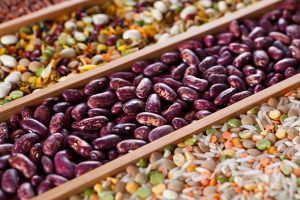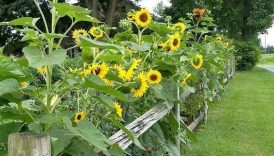How Beans Are Fueling Health and Longevity in Blue Zones

Overview of Blue Zones
The concept of Blue Zones refers to specific regions of the world where people live significantly longer, healthier lives compared to the global average. These areas have been identified as hotspots of longevity, primarily due to their unique lifestyles, social structures, and, notably, their diets. Blue Zones include places like Sardinia, Italy; Okinawa, Japan; and the Nicoya Peninsula in Costa Rica, among others. Each of these locations is characterized not just by remarkable life expectancy but also by lower rates of chronic diseases. Research indicates that the residents of these regions share common habits that contribute to their longevity. For instance, they often cultivate close-knit relationships within their communities, maintain a fulfilling purpose in life, and engage in regular physical activity. These factors combine to create a vibrant environment conducive to overall well-being. However, one of the standout elements of their lifestyles is their nutrition.
- How Beans Are Fueling Health and Longevity in Blue Zones
- Overview of Blue Zones
- Importance of Diet in Blue Zones
- Beans: A Staple Food in Blue Zones
- Varieties of Beans Consumed
- Nutritional Benefits of Beans
- Health Benefits of Beans in Blue Zones
- Role of Beans in Longevity
- Impact on Overall Health
- Bean-based Recipes from Blue Zones
- Traditional Bean Dishes
- Modern Bean Recipes
- Incorporating Beans into Your Diet
- Tips for Cooking Beans
- Bean Alternatives in Non-Blue Zones
Importance of Diet in Blue Zones
Diet plays a pivotal role in the health and longevity observed in Blue Zones. The dietary patterns in these areas are predominantly plant-based, focusing on whole, natural foods that provide essential nutrients. For example, beans are a primary source of protein and fiber in many Blue Zones diets, illustrating how simple foods can have profound effects on health. Here are some key highlights of the dietary habits in Blue Zones:
- Emphasis on Plant Foods: Fruits, vegetables, whole grains, nuts, and legumes are staples, making up the majority of daily nutrition.
- Minimal Processed Foods: Residents typically consume very few processed foods, preferring local and fresh produce.
- Moderate Portion Sizes: Traditional meals tend to be smaller, which can prevent overeating and promote healthy weight management.
The common thread running through these diets is their simplicity and wholesomeness, leading to vibrant health and longevity. By understanding these principles, anyone can start to incorporate aspects of Blue Zones diets into their own lives, paving the way to a healthier future. As we delve deeper into the dietary staples of these extraordinary regions, we will discover how beans, in particular, are a cornerstone of their nutrition and a key factor in their lasting vitality.
Beans: A Staple Food in Blue Zones
Varieties of Beans Consumed
When it comes to the diet of Blue Zones, beans reign supreme as one of the most important food sources. These tiny powerhouses of nutrition come in a variety of types, contributing to both flavor and health benefits in everyday meals. In places like Sardinia and Costa Rica, beans are not just a regular food item; they’re an integral part of cultural traditions and social gatherings. Some of the most commonly consumed varieties include:
- Black Beans: Popular in Latin American cuisine, they are rich in fiber and protein, making them a perfect addition to any meal.
- Chickpeas: Also known as garbanzo beans, they offer versatility and are frequently used in salads, stews, and even made into hummus.
- Lentils: Although technically a legume, lentils are often grouped with beans. They are a staple in Mediterranean diets and pack a powerful punch of protein.
- Kidney Beans: Rich in antioxidants, kidney beans are frequently used in dishes like chili and rice, adding both color and nutrition to the plate.
Whether served in a hearty soup, tossed into a salad, or blended into a delicious dip, beans have a way of adding both texture and depth to meals across Blue Zones.
Nutritional Benefits of Beans
The nutritional profile of beans is impressive, which is why they’re routinely highlighted in discussions around healthy eating and longevity. Here are some key benefits that make these legumes stand out:
- Rich in Fiber: Beans are packed with dietary fiber, promoting digestive health and helping to maintain a healthy weight.
- High in Protein: A fantastic alternative to animal proteins, beans provide essential amino acids that support muscle repair and growth.
- Filled with Vitamins and Minerals: Beans are laden with crucial nutrients like folate, iron, magnesium, and potassium, all of which are vital for optimal bodily functions.
- Low Glycemic Index: The slow-digesting carbohydrates in beans help regulate blood sugar levels, reducing the risk of type 2 diabetes.
Incorporating beans into daily meals not only reflects the dietary practices of Blue Zones but also promotes a wholesome lifestyle filled with vibrant health. As we explore further, we’ll uncover the myriad health benefits that beans offer, particularly in relation to longevity and overall well-being. By embracing these powerful legumes, anyone can enrich their diet and move closer to achieving a balanced, nutritious intake.
Health Benefits of Beans in Blue Zones
Role of Beans in Longevity
Beans are not just a nourishing addition to meals; they play a pivotal role in the extraordinary longevity seen in Blue Zones. Research consistently shows that regular consumption of beans can lead to not only a longer life but also a healthier one. How does this happen?
- Nutrient Density: Beans are rich in antioxidants, vitamins, and minerals that combat oxidative stress and inflammation—two major contributors to age-related diseases.
- Heart Health: Beans are known for their heart-healthy properties. Their high fiber content helps reduce cholesterol levels, thus lowering the risk of heart disease, a leading cause of mortality worldwide.
- Weight Management: Their ability to promote a feeling of fullness can help prevent overeating, allowing individuals to maintain a healthy weight—an important factor for increasing life expectancy.
Take, for example, the residents of Okinawa, Japan, who incorporate various bean-based dishes into their daily diets. Their high intake of soybeans, in the form of tofu or miso, is associated with lower incidences of chronic diseases and longer lifespans. It’s clear that beans have a fundamental place in the dietary habits of long-lived individuals.
Impact on Overall Health
The health benefits of beans extend far beyond just increased longevity; they significantly contribute to overall health and well-being. Here are a few ways beans impact various aspects of health:
- Digestive Health: The high fiber content aids in digestion and promotes regular bowel movements, helping to prevent issues like constipation and diverticulitis.
- Blood Sugar Control: Beans have a low glycemic index, which means they release sugar into the bloodstream slowly, providing steady energy levels and reducing the risk of diabetes.
- Immune Function: The rich array of vitamins and minerals strengthens the immune system, helping to fend off illnesses and infections.
Consider a family gathering in the Nicoya Peninsula where beans take center stage on the dinner table. Not only are they a source of nutrition but also a way to foster community and strengthen bonds. This lifestyle, intertwined with nutritious eating, plays a significant role in their overall health. In summary, beans are more than just a dietary staple in Blue Zones; they are a crucial component that contributes to longevity and promotes overall health. By embracing the benefits of beans, anyone can take steps toward living a longer, healthier life, regardless of where they call home.
Bean-based Recipes from Blue Zones
Traditional Bean Dishes
Beans have a long-standing place in the culinary traditions of Blue Zones, offering not only nutrition but also a taste of culture and history. Each region boasts its unique bean dishes that have been passed down through generations. Here are a few traditional favorites:
- Cascado de Frijoles (Costa Rica): This beloved dish features black beans simmered with herbs and spices. Typically served with rice, tortillas, and avocado, it showcases the delicious simplicity of Costa Rican cuisine.
- Fasolada (Greece): A hearty bean soup made with white beans, tomatoes, olive oil, and an array of vegetables, fasolada is often referred to as the national dish of Greece. It’s a staple in the diet of the islanders and reflects their plant-based lifestyle.
- Ceci e baccalà (Italy): During the winter months, Sardinians enjoy this traditional dish of chickpeas and salt cod. The combination of flavors and textures makes it a warming dish full of nutritional benefits.
These recipes not only bring families together around the dinner table but also provide a connection to the culture and values of these vibrant communities.
Modern Bean Recipes
While traditional recipes hold a cherished place in the hearts of those from Blue Zones, modern adaptations are also gaining popularity. With a focus on health and convenience, these contemporary recipes make it easier to enjoy beans in everyday meals. Here are a few to try:
- Quinoa and Black Bean Salad: Combining quinoa, black beans, corn, diced peppers, and a zesty lime dressing, this colorful salad is a refreshing take on a classic and perfect for meal prep.
- Lentil Tacos: These plant-based tacos swap meat for seasoned lentils, topped with avocado, salsa, and fresh cilantro. They’re a quick and nutritious option for lunch or dinner.
- Chickpea Pasta: Replace regular pasta with chickpea pasta for a protein-packed meal. Toss it with your favorite pesto and vegetables for a satisfying and nourishing dish.
These modern recipes highlight the versatility of beans, making it easy to incorporate this nutritional powerhouse into various cuisines and meals. By embracing both traditional and modern bean dishes, individuals can enjoy the rich flavors while reaping the health benefits that these legumes provide. Whether sticking to time-honored recipes or trying something new, beans can inspire a wholesome and delicious approach to eating.
Incorporating Beans into Your Diet
Tips for Cooking Beans
If you’re ready to dive into the world of beans, you’ll be glad to know that they are both simple to cook and incredibly versatile. Here are some tips to help you make the most of these nutritious legumes:
- Soaking: For dried beans, consider soaking them overnight. This reduces cooking time and makes them easier to digest. Simply cover them with water and let them sit at room temperature.
- Cooking Methods:
- Stovetop: After soaking, rinse the beans and simmer them in fresh water, adding flavors like garlic and onion for extra depth.
- Pressure Cooker: For a quick option, a pressure cooker can drastically reduce cooking time—chickpeas, for instance, can be ready in about 30 minutes!
- Canned Beans: If you’re short on time, canned beans are a great, convenient alternative. Just rinse them to reduce sodium content before use.
- Flavoring: Don’t shy away from spices and herbs. Adding cumin, chili powder, or bay leaves can transform the taste of beans from plain to sensational.
I remember the first time I made a bean chili for a gathering. The combination of spices and fresh vegetables turned my home into a vibrant space filled with delightful aromas. Everyone loved it, and I learned just how easy it is to create delicious bean-centric dishes!
Bean Alternatives in Non-Blue Zones
If you live outside of these Blue Zones yet want to incorporate more legumes into your diet, there are plenty of alternatives that can still give you the nutritional benefits of beans. Here’s what you can consider:
- Lentils: Versatile and quick-cooking, lentils can be used in soups, stews, or salads and are excellent sources of protein and iron.
- Peas: Whether fresh, frozen, or dried, peas are rich in vitamins and can be added to pasta dishes or pureed into spreads.
- Edamame: Young soybeans are not only tasty but also a great source of protein. They can be tossed into salads or enjoyed as a snack.
Substituting beans with similar legumes can enhance your meals while still delivering on health benefits. In conclusion, incorporating beans—or their alternatives—into your diet can be an enjoyable journey filled with discoveries. With a few cooking tips and a look into the variety of legumes available, you can enhance your meals and enjoy the many benefits that these nutritional powerhouses offer. Whether you’re a seasoned cook or just starting out, beans can effortlessly enrich your culinary repertoire.





